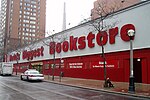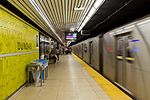Ford Hotel

The Ford Hotel was a historic hotel in central Toronto, Ontario, Canada. It was one of five hotels in the R.T. Ford & Company hotel chain and was identical to the Ford Hotel, Buffalo and Ford Hotel, Montreal. The 750-room hotel consisted of three 12-story wings connected at the rear by a perpendicular spine atop a one-story base contained the lobby, restaurants and other amenities. The structure was located on Dundas Street West, east of Bay Street. It was built in 1928 and for several decades was one of the city's most prominent hotels. The hotel was next to the Toronto Bus Terminal and provided cheap rooms for lower income travellers. It was also well known as a site for crime and vice. The Toronto Star called it the "rendezvous of choice for couples pursuing an illicit affair."The building was demolished in 1973 and the site is today home to the Atrium on Bay, now known simply as "Atrium".
Excerpt from the Wikipedia article Ford Hotel (License: CC BY-SA 3.0, Authors, Images).Ford Hotel
PATH, Toronto
Geographical coordinates (GPS) Address Nearby Places Show on map
Geographical coordinates (GPS)
| Latitude | Longitude |
|---|---|
| N 43.6563 ° | E -79.3827 ° |
Address
Atrium On Bay
PATH
M5G 2C2 Toronto
Ontario, Canada
Open on Google Maps











